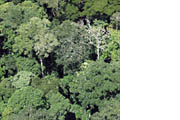The effectiveness of integrated conservation and development interventions in a Central African forest landscape
A recent study in Cameroon has found that participatory modeling is a valuable means of capturing the complexities of achieving conservation at landscape scales and of stimulating innovative solutions to entrenched problems.

Photo: Agni Boedhihartono / IUCN
Integrated conservation and development projects (ICDPs) have had limited success in addressing the often conflicting objectives of conservation and development.
Sandker et al. developed a model with local participants to explore the trade-offs between conservation and development in southeastern Cameroon, where illegal hunting is regarded as the greatest challenge to conservation.
The research team simulated the effects of different ICDP strategies by varying the degree of focus on antipoaching activities, anticorruption measures and direct development investments, and by varying the overall budget for such activities.
The outcome variables were numbers of selected wildlife species and household incomes and the model outcomes from the different scenarios were used to stimulate debate among stakeholders.
The researchers found that contributing to poverty alleviation while maintaining current animal population sizes will be extremely difficult and will require long-term external financial support.
Furthermore, devoting greater attention to improving local environmental governance emerged as the highest priority for this investment.
The model outputs were subsequently used to inform some of the major policy makers in the region.
More information can be found here in the full report.



